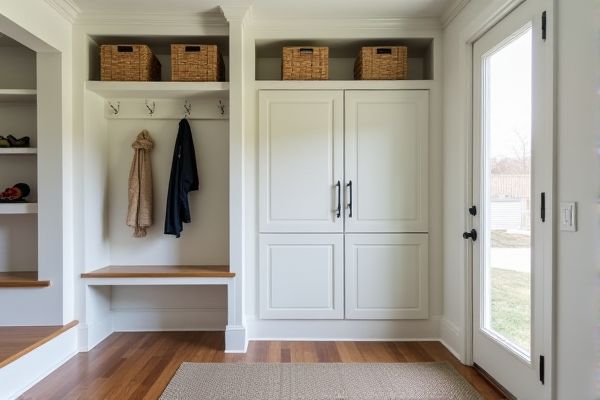
Freestanding mudroom units offer flexibility and easy relocation, ideal for renters or those seeking a non-permanent solution, while built-in mudrooms provide a seamless, customized storage area that maximizes space and adds value to your home. Discover which option best suits your lifestyle and storage needs as you explore the rest of this article.
Table of Comparison
| Feature | Freestanding Mudroom Unit | Built-In Mudroom |
|---|---|---|
| Installation | Easy, no structural changes needed | Requires professional installation and wall modification |
| Customization | Limited to pre-made designs | Highly customizable to fit space and style |
| Space Utilization | Less efficient, occupies floor space | Optimizes use of wall and floor space |
| Cost | Generally lower upfront cost | Higher cost due to materials and labor |
| Durability | Portable but less sturdy | More durable and integrated with home structure |
| Flexibility | Can be moved or replaced easily | Permanently fixed, not movable |
| Maintenance | Simple, easy to clean and repair | May require more upkeep due to integration |
Introduction to Mudroom Solutions
Freestanding mudroom units offer versatile storage options that can be easily moved or rearranged, making them ideal for renters or those seeking flexible organization. Built-in mudrooms provide a seamless, custom-fitted solution that maximizes space efficiency and enhances home value with permanent installation. Choosing the right mudroom solution depends on your specific needs for adaptability, design preference, and long-term functionality.
What is a Freestanding Mudroom Unit?
A freestanding mudroom unit is a versatile, standalone piece of furniture designed to organize shoes, coats, and accessories without the need for permanent installation. It offers flexibility in placement, allowing you to easily move or rearrange it within your space to suit changing needs. Unlike built-in mudrooms, freestanding units provide immediate functionality and style without construction or remodeling.
What is a Built-In Mudroom?
A built-in mudroom is a custom-designed space integrated directly into a home's architecture, often featuring fixed cabinetry, benches, and storage solutions that maximize organization and functionality. Unlike freestanding mudroom units, built-ins are tailored to fit specific wall dimensions and blend seamlessly with interior design elements, enhancing both style and utility. This permanent installation provides durable, space-efficient storage for shoes, coats, and accessories, making it ideal for busy households seeking long-term organization.
Key Differences Between Freestanding and Built-In Mudrooms
Freestanding mudroom units offer flexibility and portability, allowing you to easily rearrange or relocate the space according to your needs, while built-in mudrooms provide a seamless, permanent storage solution that maximizes wall space and enhances your home's architectural design. Built-in mudrooms often feature custom cabinetry and integrated seating, making them ideal for maximizing storage efficiency in smaller entryways, whereas freestanding units are typically more affordable and require less installation effort. Your choice depends on whether you prioritize customization and permanence or versatility and ease of installation in organizing your entryway.
Pros and Cons of Freestanding Mudroom Units
Freestanding mudroom units offer flexibility in placement and easy installation without permanent alterations to your space, making them ideal for renters or those who frequently move. These units typically provide versatile storage options such as hooks, benches, and cubbies, but may lack the custom fit and seamless integration that built-in mudrooms ensure. You benefit from affordability and portability with freestanding units, though they can compromise on stability and aesthetic cohesion compared to their built-in counterparts.
Pros and Cons of Built-In Mudrooms
Built-in mudrooms offer seamless integration with your home's architecture, providing customized storage solutions that maximize space efficiency and enhance property value. However, they require permanent installation, limiting flexibility for future renovations or relocation. You benefit from a cohesive, polished look but must consider higher upfront costs and potential disruption during construction.
Design Flexibility: Freestanding vs Built-In
Freestanding mudroom units offer exceptional design flexibility, allowing for easy relocation and customization without permanent alterations to the space. Built-in mudrooms provide a seamless, integrated look tailored to the home's architecture, optimizing storage and flow with fixed cabinetry. Choosing between the two depends on the need for adaptability versus cohesive, space-specific design.
Installation and Cost Comparison
Freestanding mudroom units offer easy installation with no structural changes, making them a cost-effective and flexible option for renters or homeowners seeking a quick upgrade. Built-in mudrooms require professional installation involving framing and drywall work, resulting in higher upfront costs but providing a seamless, custom appearance that can enhance your home's value. Evaluating your budget and space priorities will help determine which option aligns best with your needs and long-term home improvement goals.
Which Option Suits Your Home?
Freestanding mudroom units offer flexibility and can be moved or reconfigured easily, making them ideal for renters or those who desire customizable storage without permanent changes. Built-in mudrooms provide a seamless, space-saving solution tailored to your home's layout, enhancing property value with integrated organization. Your choice depends on whether you prioritize portability and ease of installation or a permanent, cohesive storage solution that maximizes space efficiency.
Final Verdict: Choosing the Right Mudroom for Your Needs
Freestanding mudroom units offer flexibility and easy installation, ideal for renters or those who frequently rearrange spaces, while built-in mudrooms provide a seamless, custom look with enhanced storage solutions integrated into the home's architecture. Consider factors such as space availability, budget, and long-term usage when selecting between the two options. Ultimately, the right mudroom balances functionality, aesthetic appeal, and practicality tailored to your lifestyle and living environment.
 homyna.com
homyna.com